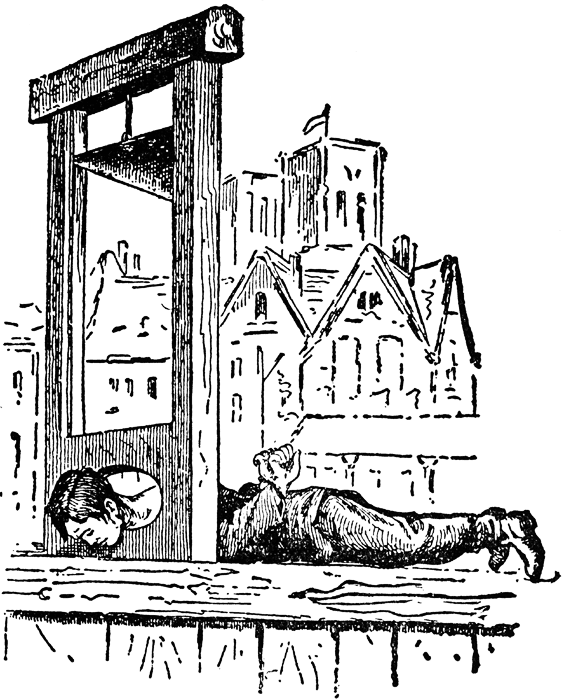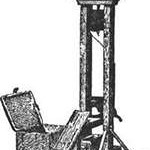The Guillotine
This content was created/compiled by Eric Moloney.
 In Brief:
In Brief:
The guillotine was a device used for carrying out executions by decapitation (cutting off the victim’s head). It was made up of a tall upright frame from which a blade is suspended. This blade is raised with a rope and then allowed to drop, separating the head from the body. The device is famous for long being the main method of execution in France, especially during the French Revolution. The guillotine continued to be used long after the French Revolution in several countries.
 Main Facts
Main Facts
- The guillotine was a device used for carrying out executions by decapitation.
- In 1971, Dr. Joseph-Ignace Guillotin (28 May 1738 – 26 March 1814) proposed the use of the guillotine to carry out death penalties in France.
- The first execution-by-guillotine was performed on highwayman Nicolas Jacques Pelletier on April 25, 1792.
- From June 1793 to July 1794 in France was known as The Terror. Former King Louis XVI and Queen Marie Antoinette were executed in 1793.
- In July 1794 Maximilien Robespierre was arrested executed by Guillotine.
- The last public guillotining was of Eugen Weidmann, who was convicted of six murders on 17 June 1939
- The guillotine remained the official method of execution in France until France abolished the death penalty in 1981. The last guillotining in France was that of torture-murderer Hamida Djandoubi on 10 September 1977.
Other facts:
- The total weight of a Guillotine was about 580 kilos (1278lb)
- The blade weighed over 40 kilos (88.2lb)
- Height of side posts was just over 4m (14ft)
- The blade drop was 2.3m (88 inches)
- Power at impact was 400 kilos (888lb) per square inch.
_______________________________________________________________________________________________________________
In Detail
The Guillotine
The guillotine was used for carrying out executions by decapitation. The blade was suspended from a tall upright frame, underneath which was a bench where the victim lay face down. The blade was raised with a rope and then allowed to drop; separating the victim’s body from the head, which then fell into a basket.
Sketches of the guillotine
Sensing the growing discontent, Louis XVI banned the use of the breaking wheel. In 1791, as the French Revolution progressed, the National Assembly researched a new method to be used on all condemned people regardless of class. Their concerns contributed to the idea that capital punishment’s purpose was the ending of life instead of the infliction of pain.
The basis for the machine’s success was the belief that it was a humane form of execution, contrasting with the methods used in pre-revolutionary, Ancien Régime France. In France, before the guillotine, members of the nobility were beheaded with a sword or axe, while commoners were usually hanged, a form of death that could take minutes or longer. Other more gruesome methods of executions were also used, such as the wheel, burning at the stake, etc. In the case of decapitation, it also sometimes took repeated blows to sever the head completely, and it was also very likely for the condemned to slowly bleed to death from their wounds before the head could be severed. The condemned or the family of the condemned would sometimes pay the executioner to ensure that the blade was sharp in order to provide for a quick and relatively painless death.
From June 1793 to July 1794 in France was known as The Terror. Former King Louis XVI and Queen Marie Antoinette were executed in 1793. Maximilien Robespierre became one of the most powerful men in the government, and the figure most associated with the Terror. The Revolutionary Tribunal sentenced thousands to the guillotine. Nobility and commoners, intellectuals and politicians all were liable to be executed on little or no grounds; suspicion of “crimes against liberty” was enough to earn one an appointment with “Madame Guillotine” (also referred to as “The National Razor”).
For a time, executions by guillotine were a popular entertainment that attracted great crowds of spectators. Vendors would sell programs listing the names of those scheduled to die. Parents would bring their children. By the end of the Terror the crowds had thinned drastically. Excessive repetition had staled even this most grisly of entertainments, and audiences grew bored.
Eventually, the National Convention had enough of the Terror, partially fearing for their own lives, and turned against Maximilien Robespierre. In July 1794 he was arrested and executed in the same fashion as those whom he had condemned. This arguably ended the Terror, as the French expressed their discontent with Robespierre’s policy by guillotining him.
The last public guillotining was of Eugen Weidmann, who was convicted of six murders. He was beheaded on 17 June 1939, outside the prison Saint-Pierre rue Georges Clémenceau 5 at Versailles, which is now the Palais de Justice. The allegedly scandalous behaviour of some of the onlookers on this occasion, and an incorrect assembly of the apparatus, as well as the fact it was secretly filmed, caused the authorities to decide that executions in the future were to take place in the prison courtyard.
The guillotine remained the official method of execution in France until France abolished the death penalty in 1981. The last guillotining in France was that of torture-murderer Hamida Djandoubi on 10 September 1977.
Debate rages over whether the quickness of the execution was humane or not, as many doctors put forward the notion that it could take up to 30 seconds before the victim lost consciousness.
An estimated 40,000 people travelled on the tumbrils through Paris to die under Madame Guillotine.
_____________________________________________________________________________________________________________
Joseph-Ignace Guillotin
Dr. Joseph-Ignace Guillotin (28 May 1738 – 26 March 1814) was a French physician who proosed the use of the guillotine to carry out death penalties during the French Revolution.
As a member of the assembly Guillotin mainly directed his attention towards medical reform. On 10 October 1789, during a debate on capital punishment, he proposed that “the criminal shall be decapitated; this will be done solely by means of a simple mechanism”. The “mechanism” was defined as “a machine that beheads painlessly”. His proposal appeared in the Royalist periodical, Actes des Apôtres.
At that time, beheading in France was typically done by axe or sword, which did not always cause immediate death. Also, beheading was reserved for the nobility, while common people were hanged. Dr. Guillotin assumed that if a fair system was established where the only method of capital punishment was death by mechanical decapitation, then the public would feel far more appreciative of their rights.
Despite this proposal, Guillotin was opposed to the death penalty and hoped that a more humane and less painful method of execution would be the first step toward a total abolition of the death penalty. He also hoped that fewer families and children would witness executions, and vowed to make them more private and individualized. It was also his belief that a standard death penalty by decapitation would prevent the cruel and unjust system of the day.
Towards the end of The Terror, Guillotin was arrested and imprisoned because of a letter from Count Mere, who, about to be executed, commended his wife and children to the care of the doctor. He was freed from prison in 1794 after Robespierre fell from power, and abandoned his political career to resume the medical profession.
Guillotin was also one of the founders of the Academy of Medicine in Paris. He became one of the first French doctors to support Edward Jenner’s discovery of vaccination and in 1805 was the President of the Committee for Vaccination in Paris.
It is sometimes said that he was eventually guillotined himself, although he actually died of natural causes in Paris and is buried in the Pere-Lachaise Cemetery in Paris.
________________________________________________________________________________________________________________
Useful Links:
The Guillotine on Wikipedia – http://en.wikipedia.org/wiki/Guillotine
Joseph-Ignace Guillotin on Wikipedia – http://en.wikipedia.org/wiki/Joseph-Ignace_Guillotin
A History of the Guillotine on About.com – http://europeanhistory.about.com/cs/frenchrevolution/a/Guillotine.htm
The Guillotine on napoleonguide.com – http://www.napoleonguide.com/guillotine.htm
_______________________________________________________________________________________________________________
History@Banagher College, Coláiste na Sionna.
The URI to TrackBack this entry is: http://teachnet.eu/tobrien/about/revolutions/the-french-revolution/the-guillotine/trackback/
7 Comments Leave a comment.
Leave a Comment
You must be logged in to post a comment.



great blog!!!!!
i didnt know it took 30 seconds for the body to lose consciousness after the the head was chopped off!!!!!
The Guillotine weighed over 500kilos!I never knew that!
I didnt think that they beheaded the nobility with a sword or axe!
I forgot to say that the blade was designed by Gilette.
haha Dr Guillotin was opposed to the death penalty!!!
The site looks great. Well done 🙂
i cant believe that it took the body three seconds to die when the head was cut off. could you imagine being alive with your head chopped off? ow!!!
wow the person who it is named after didn’t really invent it.GLORY!!!!!!!